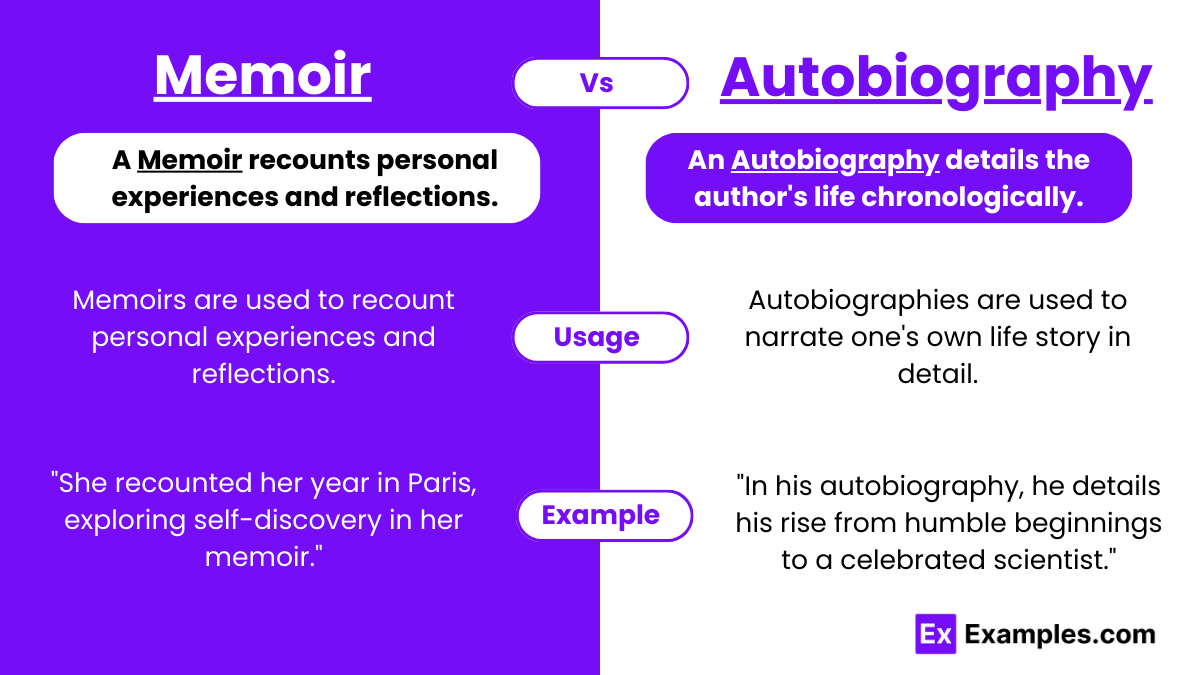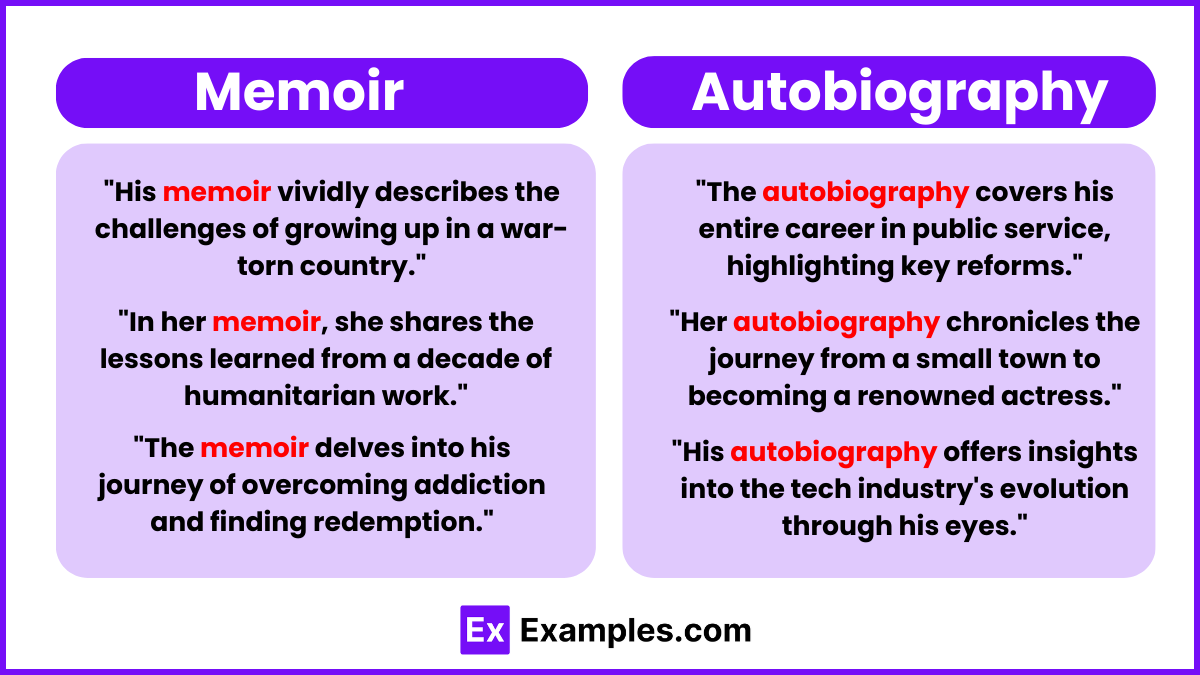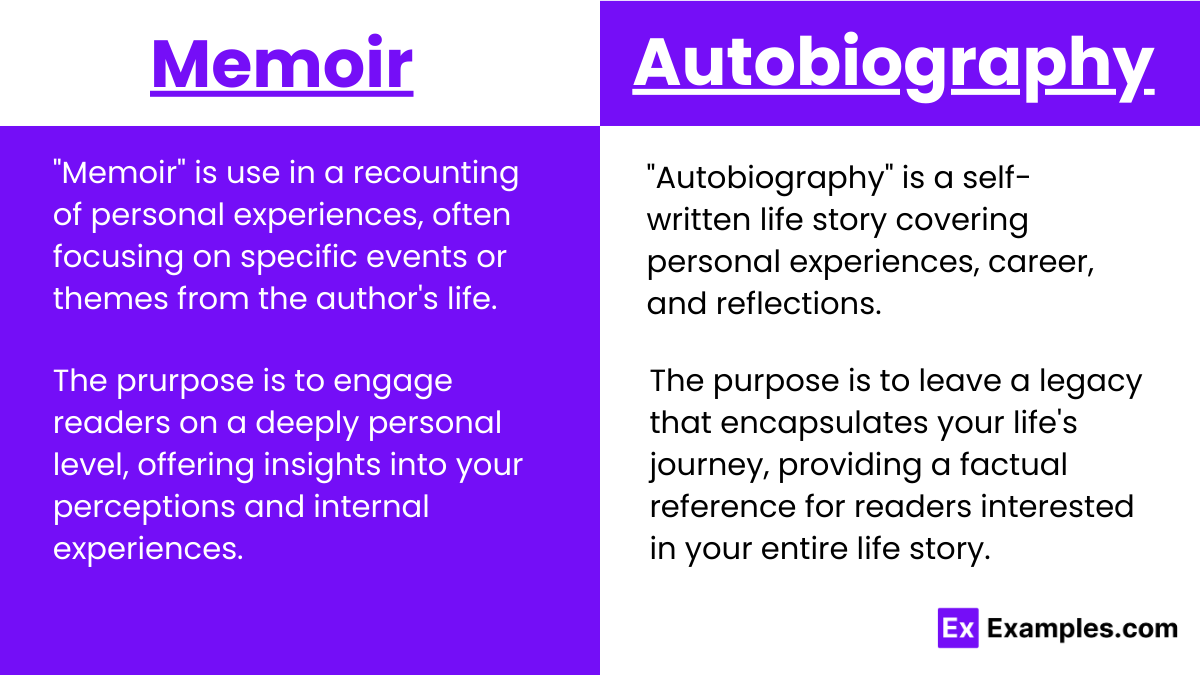Memoir vs Autobiography – Examples, Differences, Usage, Tips
The literary realms of memoir and autobiography reveals a nuanced landscape where personal narratives take center stage, yet each genre follows its distinct path. While both memoirs and autobiographies present the story of a life as told by the individual who lived it, they diverge in scope and focus, inviting readers into the author’s world through the lens of first-person narration. Memoirs offer a window into specific vignettes or periods, painting vivid pictures of moments that have shaped the author’s perspective, often tied together by a central theme or emotional journey. This selective exploration allows for a deep dive into the intricacies of human experience, emphasizing the subjective interpretation of events.
Autobiographies, by contrast, commit to a broader sweep, chronicling the author’s journey from birth to the present in a comprehensive and chronological manner. This genre demands a commitment to factual accuracy and historical context, often serving as a legacy piece that encapsulates the entirety of the author’s life. The distinction between these two forms of personal storytelling is crucial for students and readers alike, as it illuminates not only the author’s intent but also the impact these narratives have on our understanding of the human condition. Through the exploration of memoirs and autobiographies, we are invited to reflect on the nature of memory, identity, and the art of storytelling itself.
Memoir vs Autobiography – Meanings
Memoir: A memoir is a form of narrative writing where the author recounts and reflects upon specific episodes or phases in their life, emphasizing personal experiences and the emotional journey associated with them. Rather than a comprehensive life history, memoirs focus on profound moments or themes, offering insights into the author’s inner world and how particular events have shaped their perspective. This genre allows for a more intimate exploration of subjectivity and memory, often presenting a thematic or episodic structure rather than a chronological one.
Autobiography: An Autobiography is a structured, chronological account of the author’s life, detailing experiences from birth to the present day. It aims to provide a factual, comprehensive overview of the author’s entire life, including significant milestones, challenges, and achievements. Autobiographies often incorporate broader historical and cultural contexts, giving readers a detailed backdrop against which the author’s life unfolded. This genre emphasizes factual accuracy and completeness, serving as a historical document that captures the entirety of the author’s personal and professional journey.
Summary
Memoir and autobiography are closely related nonfiction genres that both delve into the author’s life story, narrated in the first person, making extensive use of personal pronouns like “I” and “me.” Despite their apparent similarities, including their factual basis and personal narrative style, they diverge in scope and intent. Memoirs offer a curated glimpse into pivotal moments or themes, weaving a tapestry of significant experiences that have shaped the author’s identity and worldview. In contrast, autobiographies present a comprehensive, chronological exploration of the author’s life, providing a detailed and historical documentation from birth to the present, encapsulating the full spectrum of life’s events and milestones.
Difference Between Memoir and Autobiography
Memoirs, with their reflective and thematic nature, invite readers into the author’s heart and mind, spotlighting transformative moments and emotional truths. Autobiographies, on the other hand, offer a panoramic view of the author’s journey, meticulously charting the course from birth to the present, often within a broader historical and societal context. This comparison aims to illuminate the unique qualities of each genre, guiding readers, writers, and students in distinguishing between these closely related but fundamentally different narratives.
| Aspect | Memoir | Autobiography |
|---|---|---|
| Focus | Centers on specific themes or experiences. | Encompasses the author’s entire life. |
| Scope | Selective and thematic. | Comprehensive and chronological. |
| Narrative Style | Reflective, emphasizing personal insights and emotions. | Factual, with attention to historical accuracy. |
| Purpose | To share personal reflections and insights. | To document the factual history of one’s life. |
| Structure | Non-linear, organized around themes or events. | Linear, following the sequence of life events. |
| Audience Engagement | Seeks to connect emotionally and philosophically. | Aims to inform and educate about the author’s life journey. |
| Content | May focus on a particular period or aspect of life. | Covers a wide range of personal and professional experiences. |
| Detail Level | Can be detailed about specific moments, less so about others. | Generally detailed across all life stages. |
| Historical Context | Less emphasis on historical context outside personal relevance. | Often situates personal story within broader historical events. |
| Common Themes | Growth, personal challenges, relationships. | Achievements, milestones, historical significance. |
By exploring these distinctions, readers and writers alike can better appreciate the depth and breadth of personal storytelling, whether it’s capturing the essence of pivotal moments in a memoir or chronicling the expansive narrative of a life in an autobiography.
Examples of Memoir and Autobiography
Memoirs allow authors to delve into specific facets of their lives, offering readers a glimpse into their personal experiences, emotions, and reflections on pivotal moments. These narratives often focus on a particular theme or period, bringing forth a deep, introspective journey.
Memoir Examples:
- “She recounted her year in Paris, exploring self-discovery in her memoir.”
- “His memoir vividly describes the challenges of growing up in a war-torn country.”
- “In her memoir, she shares the lessons learned from a decade of humanitarian work.”
- “The memoir delves into his journey of overcoming addiction and finding redemption.”
- “Her memoir paints a poignant picture of life as a first-generation immigrant.”
Autobiographies present a comprehensive account of an individual’s life, narrated from birth to the present. These works often weave personal achievements and challenges into the broader historical and cultural context of the author’s lifetime.
Autobiography Examples:
- “In his autobiography, he details his rise from humble beginnings to a celebrated scientist.”
- “Her autobiography chronicles the journey from a small town to becoming a renowned actress.”
- “The autobiography covers his entire career in public service, highlighting key reforms.”
- “She traces her lineage and personal growth in her revealing autobiography.”
- “His autobiography offers insights into the tech industry’s evolution through his eyes.”
When to Use Memoir and Autobiography
Choosing between writing a memoir and an autobiography depends on the author’s intent, the story they wish to tell, and how they want to connect with their audience.
Usage of Memoir
- You want to focus on specific, impactful periods or themes in your life rather than a comprehensive chronology.
- You’re aiming to explore and reflect on the emotional and philosophical lessons learned from your experiences.
- You prefer a narrative that allows for a more creative and less linear structure, centered around personal growth, particular events, or relationships.
- Your goal is to engage readers on a deeply personal level, offering insights into your perceptions and internal experiences.
Usage of Autobiography
- You intend to provide a detailed account of your life from birth to the present, covering all major phases and milestones.
- You aim to document your life’s achievements, challenges, and contributions within a broader historical, cultural, or professional context.
- You’re committed to factual accuracy and chronological structure, offering a historical record of your life.
- Your purpose is to leave a legacy that encapsulates your life’s journey, providing a factual reference for readers interested in your entire life story.
How is an memoir and autobiography structured?
Memoir Structure
- Introduction: Introduces the theme or central idea of the memoir, often with an engaging hook to draw readers in.
- Chronological or Thematic Narration:
- Chronological: Events are presented in the order they occurred, focusing on specific periods or events in the author’s life related to the central theme.
- Thematic: The memoir is organized around themes or lessons rather than in strict chronological order, weaving different times and events together based on subject matter.
- Vivid Descriptions and Reflections: Detailed descriptions of people, places, and events, coupled with the author’s personal reflections and emotional responses.
- Character Development: Focus on the growth and changes in the author over time, highlighting turning points and key experiences.
- Climax or Turning Point: A pivotal event or realization that represents the peak of the narrative arc, often leading to a significant change or insight.
- Resolution and Conclusion: Wraps up the narrative, tying together the main themes and reflecting on the journey, sometimes looking to the future or offering a final thought or lesson learned.
Autobiography Structure
- Early Life and Background: Introduction to the author’s family background, childhood, and formative experiences.
- Chronological Progression:
- Linear Narrative: The story unfolds in a linear fashion, detailing the author’s life from early years through adulthood, in a more comprehensive manner than a memoir.
- Educational and Career Milestones: Emphasis on the author’s education, career development, and significant achievements.
- Significant Relationships and Influences: Discussion of key relationships and people who have had a significant impact on the author’s life and development.
- Challenges and Overcoming Adversity: Accounts of major obstacles, challenges, and how they were overcome, contributing to the author’s character and life story.
- Personal Philosophy and Reflections: Insights into the author’s beliefs, values, and philosophical outlook on life, often intertwined with their life story.
- Later Life and Legacy: The later stages of the author’s life, their reflections on their experiences, and thoughts on their legacy and contributions.
- Conclusion: A final overview of the author’s life, encapsulating the key messages and lessons of the autobiography, and sometimes offering advice or inspiration to the reader.
Tips for Memoir and Autobiography
- Reflect Deeply: Before writing, spend time reflecting on key life moments and the lessons learned from them.
- Identify a Central Theme: Determine the core message or theme of your story to provide focus and coherence.
- Create a Structured Outline: Organize your thoughts and memories to guide your writing process and ensure a logical flow.
- Emphasize Emotional Truth: Share your experiences with honesty and vulnerability to create a genuine connection with readers.
- Utilize Vivid Descriptions: Use sensory details and vivid imagery to bring your story to life and immerse readers in your experiences.
- Incorporate Dialogue: Use conversations to add dynamism and reveal character traits and pivotal moments.
- Connect with Broader Themes: Relate your personal story to larger historical, cultural, or social contexts for added depth.
- Edit and Revise Thoroughly: Be prepared to refine your work, focusing on clarity and emotional impact.
- Maintain Your Unique Voice: Ensure your personal tone and style are evident throughout your narrative.
- Seek Feedback and Guidance: Consider input from trusted individuals or professionals to enhance your manuscript.
FAQs
What are the key similarities between memoir and autobiography?
Both memoirs and autobiographies are nonfiction narratives focusing on the author’s life. They often include personal experiences, reflections, and significant events, presenting a detailed account of the author’s journey, allowing readers to gain insights into their perspectives and challenges.
How do memoirs and autobiographies differ?
Memoirs typically focus on specific themes or periods within the author’s life, emphasizing emotional experiences and personal growth. Autobiographies provide a more comprehensive life history, detailing the author’s entire life from birth to the present or up until the writing of the book.
Should I write a memoir or autobiography?
Choose to write a memoir if you wish to share poignant, thematic stories from your life, focusing on emotional truths and personal growth. Opt for an autobiography if your goal is to document your entire life story, offering a chronological and factual account of your experiences.
How do you end a memoir?
End your memoir by reflecting on the journey shared, highlighting the lessons learned and how these experiences have shaped you. A compelling conclusion often ties back to the beginning, offering closure and leaving readers with a lasting impression of your personal growth and insights





